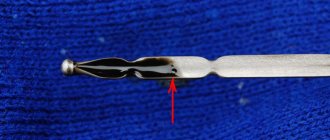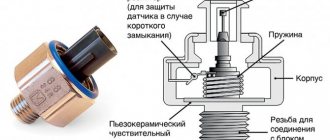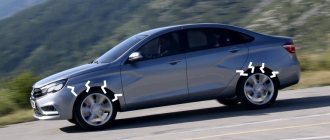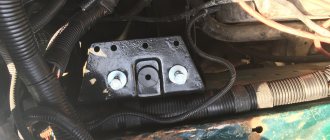April 10, 2017 Lada.Online 181 643 9
Currently, all LADA models (Lada XRAY, Vesta, Largus, Granta, Kalina, Priora, Niva 4×4) without exception are equipped with ABS (anti-lock braking system). During the operation of the car, many owners notice that the ABS and ESC lamps (if this system is available) light up on the instrument panel. Let's figure out how to solve this problem and improve the design.
How ABC works
The anti-lock braking system was developed when it became clear that when the wheels suddenly jam, the car loses stability and is difficult to control. Moreover, the quality of braking did not improve, and the car was pretty much carried off the road. Therefore, a system was developed that, by regulating the pressure in the brake system pipes, allows the wheels to turn slightly. This significantly improves vehicle dynamics, allowing the driver to control the vehicle more confidently. But despite its apparent simplicity, this is a rather complex process that requires the coordinated operation of many mechanisms included in the anti-lock braking system. If any of the components fails, a warning lamp lights up on the instrument panel.
You can often hear the question from drivers: “Why is the ABS sensor on?” It is important to know that when the warning light comes on, it does not necessarily indicate a faulty wheel sensor.
ABS turns on randomly, the light blinks or lights up periodically
One of the most difficult forms of breakdowns is the constant blinking of the ABS light. This means that the anti-lock braking system sensors send incorrect signals to the computer, which, in turn, issues other incorrect commands to the vehicle's systems and modules. In such cases, many people prefer to simply turn off the anti-lock system, since unpleasant incidents may occur. For example, turning on ABS at a speed of 90 kilometers per hour with light braking can damage the chassis of the car and contribute to a complete loss of control over control. It's better to do this:
- bring the car to a service center for diagnostics, find out the reason for the chaotic operation of the equipment;
- for domestic cars equipped with a primitive anti-blocking device, it is better to immediately disable the system;
- complex designs and on-board electronic systems of foreign cars will have to be reflashed for repair;
- on some machines it will be easier to find the problem and fix it than to disable the anti-lock;
- you need to keep in mind that this particular system is not always the cause of the ABS light coming on; the problems can be different;
- During the diagnostic process, it is better to check the entire on-board electrical system and equipment.
By paying a certain amount for a car inspection, you can get the right answers to important questions. Sometimes a light that comes on on the panel can develop into a full-fledged repair of important units and components of the car, so you will have to spend a lot. But in most cases, this problem is not so expensive to solve. The cost of repair work depends, of course, on the make and model of the car, and on the price of spare parts. If an ABS sensor for a domestic car costs from 600 rubles, then a Japanese SUV will cost more than 10,000 rubles to replace one such sensor.
How ABC works on Lada Priora
Like most modern car systems, ABS is computer controlled. But in addition to the electronic control unit, it also includes several sensors and actuators. The entire system consists of several elements. 1
.
Electronic control unit (ECU). 2
.
Sensors on wheel hubs 4 pcs. 3
.
Brake fluid pressure valves in the system 4 pcs. 4
.
EVN (Electric Return Pump). 5
. Warning light on the instrument panel. Despite all its apparent simplicity, this is a rather complex, high-tech system. Each sensor transmits data on the rotation speed of the Priora wheel to the electronic control unit. Based on the data received, the control unit sends a signal to the brake system valve, which, when you press the brake pedal, releasing pressure, prevents the wheels from completely locking and starting an uncontrolled skid of the car.
The need to replace the device
Malfunctions in the ABS system are indicated by a warning lamp located on the dashboard of the car. In normal mode, the indicator lights up when the engine starts and goes out after 3–5 seconds. If the controller behaves incorrectly - it turns on while the engine is running or blinks chaotically when the car is moving - this is the first sign of a sensor failure.
The ABS indicator should go out 3-5 seconds after starting the engine
Also, a possible device malfunction is indicated by:
- an error code appears on the on-board computer display;
- continuous wheel locking during heavy braking;
- absence of characteristic vibration on the brake pedal when it is pressed;
- the parking brake indicator lamp has been activated when the handbrake is off.
If any of these problems occur, the device should be fully diagnosed. It is not at all necessary to trust this question to highly paid car service technicians - checking the ABS sensor yourself takes little time and is done without expensive equipment. If diagnostics reveal that the device is broken, it will have to be replaced with a new one.
ABC control unit on Priora
Structurally, on the Priora, the ABS ECU is mounted together with the EWH and valves that regulate the pressure into a single unit - the hydraulic unit.
It is located on the front left side member of the vehicle. The hydraulic unit is connected to the entire system by a common wiring harness. It includes pipes for supplying brake fluid to the working cylinders. An EWH is also installed here, increasing the pressure in the system. This unit does not understand handicraft conditions. Usually replaced entirely with a new one.
What to do if the ABS system starts to work incorrectly and the indicator blinks?
This situation is one of the most complex system failures. The thing is that the sensors read incorrect information and transmit it to the control device, which for this reason gives incorrect commands to the actuators. Unfortunately, most vehicle owners, when detecting this malfunction, simply turn off the ABS system, since this is an effective measure to prevent serious consequences while driving. For example, spontaneous activation of the system while driving at a speed of more than 90 km/h can lead to serious damage to the suspension, which will provoke an emergency situation as a result of loss of control over the car. In this case, you need to do this:
- perform system diagnostics at a car service center;
- if the ABS system is installed on a domestic car, it must be disabled;
- it is quite possible that after repairing the ABS, the ECU will need to be reflashed, but this measure is applicable mainly for foreign cars;
- disabling the anti-lock system is not a solution to the problem, since on most vehicles its presence is simply necessary and is determined by the design features of their chassis, body and frame;
- You should not completely rule out the presence of faults in other components of the car that cause interruptions in the operation of the ABS.
It is necessary to remember that only diagnostics using special equipment will help to establish the real reason for the incorrect operation of the anti-lock system, which may lie in the malfunction of its components or other components of the vehicle. Therefore, you should be prepared for anything. But in many cases the problem can be solved quite simply. The cost of restoring the ABS system will depend only on its design and the make of the car. But the need to carry out this work is dictated by the safe operation of automotive equipment, the design of which includes such a system.
Problems caused by the ABS system cannot be called difficult to solve, but in any case they require immediate elimination. As you can see, the banal shutdown of the system, which most car owners consider a panacea in the event of a malfunction, is not always this magic remedy. All that needs to be done is to correctly identify the malfunction and eliminate it, because in most cases, it is not related to the functioning of the anti-lock system.
The abs sensor of a Priora car is placed near the wheels. It comes in front and back. The ABS unit is placed near the engine on the right, if you open the hood and stand in front of the car. When AbS (ABC) lights up on the panel, it means there is a problem with the system. Why do cars need this system? Abs affects the braking of the car, Priora with this system brakes 2 times faster than without it. The wheels brake in small portions, measured by a computer. Initially in 2008 there were cars without it. Read the article to the end and find out what the error is, what it is responsible for and why the ABS lights up and does not work. Priora has sensors and an ABS unit. Failure of any spare part leads to problems. On the Prior, there are 18 errors belonging to the braking system.
The appearance of an icon on the dashboard indicates an error occurring in the operation of the vehicle. There are serious errors on the Priora, if they occur, you should not tempt fate and move on, but there are errors that can be postponed. For example, the ABS system is considered very valuable for a modern driver in a car.
The Priora's ABS system saves you during unexpected and sudden braking and makes the process itself more efficient, reducing the braking distance. Therefore, when the ABS light is on on the Priora’s dashboard, strange feelings of uncertainty arise - knowing that the road situation can be so unpredictable that you will have to brake sharply, you involuntarily have to look for the reason why the icon appeared on the dashboard.
As in many systems, this behavior of the car's control unit may result in the ABS sensor on the Priora having to be replaced. A large system with a fairly simple device is worth checking - for your own safety.
ABS sensor on the hub
The sensors that supply wheel speed data to the control unit are made on the principle of a Hall sensor. By the way, most rotation sensors use exactly this principle: changing the voltage on the semiconductor of the sensor, depending on the passage of a control point on the rotating disk near it. It is in correlation with the signals from the ABS sensors that the control unit manipulates the valves.
Why does the ABS light even come on?
In a normally running vehicle, this indicator shows you that the wheels have been unlocked. In this case, everything works fine, the sensors sensed the need to turn on the safety system, initiated its operation and demonstrated to the driver that some assistance was provided when braking. When you see the ABS light on while braking, it is better to release the brake pedal a little and take over control of the car. If you have an expensive, high-tech car, you can trust the well-thought-out systems and let ABS+EBD do the job. In other cases, the light may be on for the following reasons:
- the sensors are clogged, the on-board computer indicates that the diagnostic error code should be read;
- Dirt or rust got on the sensors, which caused the anti-lock braking system to turn on incorrectly;
- there is a problem in the on-board electrical system, which is demonstrated by random lights coming on;
- the wheel bearing has failed, which forces the sensors to constantly turn on the anti-lock braking system by mistake;
- the fuses in the unit responsible for the ABS system have failed and are passing the signal directly;
- There was an error in the computer that caused the ABS light to come on.
Also, sometimes troubles occur with the generator and other elements of the machine’s electrical circuit, which can result in the lighting of the diagnostic system light or warning lights of any type. For example, on a Volkswagen car produced in the 2000s, the anti-lock braking system light comes on even if there is an error in completely different components. Therefore, self-diagnosis is only a partially acceptable method of solving the problem, because often the driver does not have special tools at hand for a good investigation.
Electronics
This is a failure of components associated with electronics:
• breaks in the electrical wiring harness; • failure of rotation speed sensors; • break or short circuit of the control valve activation coil; • failure of the return pump electric motor; • valve activation relay failure; • program failure, or failure of the ABS control unit.
ABS FAULTS IN THE FIELD OF HYDROMECHANICS
In this case, the most typical failures are leakage of oil seals in various connections and assemblies. Deterioration of working surfaces on disks, and as a result, a change in the distance between the sensor and the readable surface. System valves jamming. Clogging of hydraulic drive pipes and breakdown of the working part of the return pump.
DETERMINING ABS MALFUNCTION
The serviceability of the ABS system in the Priora, like in any car, is a very important issue. It is very convenient that the slightest malfunction in its operation will immediately be reflected on the dashboard. The ABS warning light will come on or it will not go out after the required time after turning on the ignition.
There's no need to think twice about it. You urgently need to go for computer diagnostics to a decent service station. Modern Priora ABS ECUs have access to a diagnostic connector. They are perfectly diagnosed by both portable portable scanners and stationary motor testers. Since all ABS electronics are very closely connected with the mechanical part, most breakdowns in this area can be determined by an experienced diagnostician by scanning the ECU. For example, the operating valve is jammed in one of the directions. What happens: the coil, figuratively speaking, tries to influence him, but he doesn’t move. The computer, noticing a load violation in the circuit, will immediately give a signal. The “ABS sensor” will light up. When connected, the technician will see the direction that needs to be looked at and quickly fix the problem.
FEATURES OF ABS PRIOR DIAGNOSTICS
Some scanners that read faults recorded in the ECU produce only alphanumeric codes, so for particularly meticulous car enthusiasts it makes sense to have on hand the decoding of these codes for the VAZ Priora: C0035 - malfunction of the left front sensor; C0040 – the same for the front right; C0045 – rear left malfunction; C0050 – the same for the right rear; C0060 – failure of the left front exhaust valve; C0065 – front left intake valve failure; C0070 – malfunction of the front right exhaust valve; C0075 – malfunction of the front right intake valve; C0080 – rear left exhaust; C0085 – rear left inlet; C0090 – rear right exhaust; C0095 – rear right intake valve; C0110 – return pump circuit malfunction; C0121 – failure in the relay circuit for turning on the supply voltage of the valves; C0161 – malfunction in the brake light circuit; C0245 – incorrect reading of rotation speed; C0550 - ECU malfunction; C0800 - voltage mismatch in the ABS network. This list allows you to find a fault, even if a simple scanner for a Priora produces only codes, and find out why the “ABS sensor came on.” Still, it is worth remembering that it will be more pleasant for the technician to hear the correct wording - the anti-lock system malfunction lamp is on.
Reasons for ABS system failure and what to do
Water getting into the contacts of the ABS control unit
We find the system control unit under the hood. It usually looks like a rectangular iron box with several metal tubes. There may be five or four of them. This is the anti-lock braking system unit. The power and control connector is connected to it - a large plug, it only fits the case, you won’t get it mixed up.
Disconnect the negative terminal of the battery and disconnect this connector from the ABS control unit. We check its contacts for moisture or mechanical damage. There were cases when they rotted and were destroyed by age and water, despite the moisture-proof casing of the connector. It may be damaged, allowing water to penetrate inside.
What to do
If you find moisture inside, blow and dry the plug and contacts both on it and on the control unit. If there is visible damage to the contacts of the plug, only replace it; if there is visible damage to the contacts of the ABS computer, then contact specialists who can replace the connector.
Fuse box
This is the simplest thing that a simple driver can check on his own if the ABS light comes on. It is advisable to check them first - this is the easiest way. We wipe our hands and climb under the hood, looking for a mounting block - a plastic box with fuses and relays.
Open it and turn over the top cover. It usually says where and what fuses are located in the block. We find the inscription “ABS” and according to the diagram we look for the fuse that is responsible for this system.
What to do
Checking the fuse. Usually there should be spare fuses in the mounting block if the machine is completely new. If there are none, then you can use the adjacent fuse. For example, remove a fan, horn, or other less important systems that were definitely working from the power socket. And insert in place of the old ABS fuse.
If the light goes out, then it's time to change it. Do not forget to return the “neighbor” to its place, otherwise the fan or other equipment from which the fuse was removed will not work.
Mud and snow
Further verification becomes a little more complicated. The sensors are located on the wheel hubs. Snow or dirt may stick between them and the gear, also called the ABS ring. They stop reading the rotation speed, and the ABS error light comes on.
Sometimes water gets into this gap between the sensor and the ring. The readings will no longer be sent to the control unit, and an error will appear on the instrument panel.
What to do
Cleaning it yourself will be problematic, but it is possible. We remove the sensor and inspect the ring teeth and its seat for frequency. Clean if necessary. If there is snow or water, then after a long trip the light should go out. If it continues to burn, then proceed to the next stage of testing.
Sensor wires
They are often rubbed by wheels or turning mechanisms. Because they are located next to the rotating elements of the chassis. The fasteners on them may break, the wiring will dangle, touching everything.
Over time, the insulation of wires and connectors may dry out. A short circuit occurs to the vehicle body. This also causes an ABS error.
What to do
Since we have already jacked up the car, let's inspect these wires. As I said, the sensors are screwed into or attached to the hubs of each wheel. Therefore, you need to inspect all four separately.
Wires can reach one meter. Your task is to examine them entirely. They may have abrasions, microcracks and other damage. The contact caps may also be torn. If you find any wiring defects, replace them; the ABS light should go out.
ABS sensors
They may get damaged. Chips stick to them - “work-out” from the gear rings. The contacts on the connector connecting the wire to the sensor may become oxidized. This will result in a poor connection. The control unit does not “see” the sensor in the system and will display an error on the dashboard.
What to do
If it is possible to unscrew the sensors from the hubs yourself, visually check their condition. We clear away any shavings, if any. If there is damage, we replace the sensor.
Remove the caps for connecting the wiring to the sensors. We check for oxidation and contact integrity. If they are green, we clean them from oxides; if they are destroyed, we change the wire with the connector or the sensor.
In what cases is it necessary to remove the instrument panel?
Disassembly of a Priora order is necessary for tuning or replacing burnt out lamps. The VAZ 2170 is a modern model, so there are not many fastenings on the panel. For disassembly you will need a set of screwdrivers. Don't forget to turn off the minus battery.
The process begins with removing the mounting block. To do this, you need to slide the latches on the fuse cover and then disassemble it;
Why does the ABS light come on?
Based on how the anti-lock braking system is designed, we can easily conclude that the lamp can be on for the following reasons:
- This could be a malfunction of ABS sensors installed near the wheels, damage to the electronic unit, or wiring. Problems with the crowns on the wheel hubs cannot be ruled out. Often, parts of the chassis may shift or change their position, as a result of which the position of the sensors is disrupted. The malfunction may also be caused by a blown fuse.
- On some models from VAG, which were produced in the late nineties, there is one feature that is associated with the inclusion of an ABS error signal, and the fault itself is located in another unit.
All of the above can lead to the ABS light coming on when the car is moving. For example, vibrations caused by an uneven road very often lead to a break in the wiring. When driving on bad roads or where there are no roads at all, the sensors may become covered with dirt and sand.
This will not allow them to transmit the correct information to the electronic unit and will cause the light to remain on.
Self-diagnosis
Car diagnostic specialists recommend initially looking for the fault yourself. The first thing you should do is visit a car wash and thoroughly clean the rims and hubs, as well as the places where the ABS sensors are installed. Quite often after washing the system begins to work properly. If after this nothing happens, then you should move on to detailed diagnostics.
In order to find out why the anti-lock braking system malfunction signal occurs, you can use a very simple test. The vehicle is accelerated to a speed of approximately 100 kilometers per hour, then the radio is turned off and the windows are closed. If you hear a characteristic noise coming from the area of the front or rear wheels, then the hubs or bearings need to be replaced.
Additionally, you can check other nodes. Check the fuse box and, if there are faulty fuses associated with the anti-lock braking system, replace them. If possible, if the ABS light is on, try to determine the error code - using it you can quickly identify the element that is causing the problem.
It is also worth consulting with an experienced mechanic, describing to him the situation and the essence of the problem. Then you can try to restore the correct operation of the anti-lock braking system with your own hands.
Next, the sensors are checked. You may have to jack up the car and remove the wheels to access them. It would be a good idea to conduct a full inspection and tests of the electronic control system of the components in the car.
The abs and handbrake light came on. Looks like it's decided!
I drove calmly, braked just as calmly, with a little blocking, but the abs seemed to work, and immediately these 2 lights appeared.
Abs stopped working. Then the lights disappeared. I braked sharply on purpose, the abs worked for a moment, then turned off and the lights came on again. The brake fluid is normal, the pads have 7 thousand miles (ferodo). Half the mileage on the highway.
I arrived for service, the diagnostics showed an error - uneven rotation of the wheels, and that the pump was not pumping well. We decided to start with the abs block to see what could be wrong with the pump. We disassembled it, the motor cover turned out to be coated with sealant, which means it has already been opened?! I learn more and more secrets. In short, everything was fine with the motor, we put it back together, pumped the brakes, the error disappeared. At this point, the first day of repair was completed, it took 4 hours, and 1200 for the work. Maybe this was the case, I thought, because they wrote to me here in the community about leveling. But still the error is uneven rotation...
We agreed that I would come again the next day to continue searching. It may seem that money was sucked out of me, but this is not so, the service is normal. In general, I arrived and started with the wheels, lifted them, spun them, the right rear wheel turned harder than the left one. In general, the problem is in the handbrake cable. I went and bought a set of cables and copper grease for the drums.
We were unable to take a photo of the abs sensor on the left wheel; it was melted. But I couldn’t find it in stock anywhere near the service center(. As luck would have it, the brake cylinder also started leaking on the rear, only the right wheel. It’s dangerous, of course, to drive like that, but I put it off for later. Still, copper grease will be needed more than once. You need a belt will change again. In general, the error never appeared. I paid 1000 rubles for the work. The brakes were bled using a new installation, and not “pump-hold-release.”
But I changed all the filters, while I was buying the cable I decided to take them, although I was going to do it on an existential basis. 3 filters came out to 865 rubles (all), on existential it would have worked out the same way, and Manov’s ones, except for the salon one.
Source
Let's sum it up
As you can see, the ABS system is not particularly complex in terms of design, but it performs important functions and directly affects safety. For this reason, it is recommended to carry out preventive diagnostics of ABS, as well as eliminate any failures and malfunctions of the system if the slightest sign of trouble occurs.
In any case, if the ABS light is on, it should be taken into account that the anti-lock braking system is disabled and sudden braking will lead to wheel locking. For this reason, it is important to avoid situations where emergency braking is required, and to detect and correct the malfunction as quickly as possible by actively applying the methods described above.
Why do the brakes on your car squeak, you can hear the brakes grinding, whistling or squeaking when braking: the main reasons. Brake pads squeak, what should the driver do?
The brake pedal is too tight, does not press down or has become soft, the brakes fail: main faults, diagnostics and troubleshooting methods.
How to brake correctly in a car with a manual transmission: types of standard braking on a manual transmission, emergency and emergency braking, tips.
The brake pedal is soft after replacing the brake pads: why are the brakes weak, is it necessary to bleed the brake system. What nuances should you pay attention to?
What is an automatic transmission brake band: the purpose of the element and its features. Signs that your brake band needs adjustment and how to adjust it.
The brake pedal falls to the floor, the brakes disappear unexpectedly, after replacing the brake fluid, pads, brake discs: the main causes of the malfunction.











